Analyzing Racial and Ethnic Data in the Survey of Young Workers
Key Findings
- White Respondents Lead in Educational Attainment
- Black and Hispanic Respondents Lag in Early Work Experience
- Black and Hispanic Respondents Lead in Unemployment and Underemployment
- Black Respondents Have Lower Rates of Contingent Work
- White Respondents Lead in the Perception of Upward Career Mobility
- Black Respondents Lag in Financial Stability
- White Respondents Have Greater Access to Social Capital Networks
- Job Outlook Is Consistent across Racial and Ethnic Groups
White Respondents Lead in Educational Attainment
Educational attainment is highly correlated with economic success, even more so for this generation than previous ones. In an increasingly knowledge-based economy, young adults who do not have any postsecondary education typically earn lower wages and experience higher rates of unemployment than their counterparts did one and two generations ago.4
The Survey of Young Workers finds that the educational attainment of white respondents places them in a better position for obtaining a job with upward mobility and higher earnings than either black or Hispanic respondents. White respondents earned postsecondary degrees at a greater rate than black and Hispanic respondents (figure 1). Although Hispanic respondents earn associate's degrees (11 percent) at a greater rate than the total sample (9 percent), they earn bachelor's degrees and higher (12 percent) at a much lower rate than the total sample (21 percent). Black respondents earned associate's degrees (3 percent) and bachelor's degrees and higher (13 percent) at a much lower rate than the total sample.
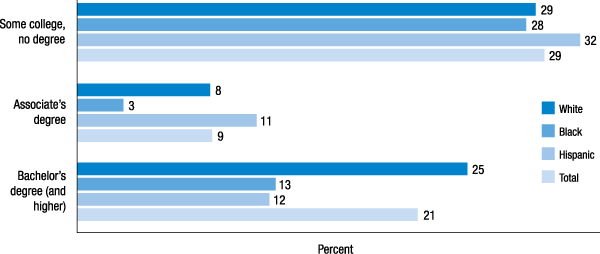
As noted above, 29 percent of the total survey respondents reported having some college education but no degree. Some of these respondents will complete their degree going forward, especially if they are currently enrolled in school. While white, black, and Hispanic respondents reported similar rates of "some college, no degree" (29 percent, 28 percent, and 32 percent, respectively), white respondents were far more likely to be currently enrolled in an educational program (53 percent, 36 percent, and 37 percent, respectively) (figure 2). Furthermore, white respondents were more likely than black or Hispanic respondents to be enrolled in school full time (43 percent, 26 percent, and 24 percent, respectively).
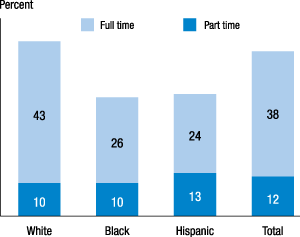
The Survey of Young Workers indicates that white and Hispanic respondents have greater educational aspirations than black respondents. While white respondents had greater levels of educational attainment, Hispanic respondents were more likely to be interested in obtaining additional education (59 percent) than black (49 percent) respondents. The Survey of Young Workers responses do not explain these findings. However, it is possible that black respondents have lower expectations about their job paths (i.e., glass ceiling) or that they lack some understanding about the changing demands of the labor market.
Black and Hispanic Respondents Lag in Early Work Experience
A 2014 study by the Brookings Institution found that teen employment is associated with improved employment and earnings outcomes later in life. Although problems finding work affected all young people in the past decade, those with work experience, those with higher levels of education, and those from higher-income households have been more successful in the labor market. Because teen and young adult unemployment is concentrated among less-educated and low-income individuals, this phenomenon threatens the upward mobility of already vulnerable populations.5
Furthermore, labor market outcomes for young adults in the post-recession period differ across racial and ethnic lines. For example, in 2011, black teenagers from 16 to 19 years old had the highest rate of underutilization (60 percent), followed by Hispanics (52 percent), Asians (48 percent), and whites (35 percent). As with teens, young adults' (aged 20 to 24 years) underutilization was highest among blacks (42 percent), followed by Hispanics (32 percent), whites (24 percent), and Asians (22 percent).6
In the Survey of Young Workers, 57 percent of all full-time students and 55 percent of all part-time students were both working and attending school. Consistent with the Brookings findings, respondents who had a paid job during high school were more likely to be currently working (69 percent) than those who did not have a paid job during high school (48 percent).
In addition, in the Survey of Young Workers, white respondents were more likely to have worked both while attending high school and while attending college than black or Hispanic respondents (figure 3). According to the research cited above, these respondents will be better positioned for success in the labor market in the long run.

Note: Number of responses for "high school" is 2,097; for "college" is 1,548.
Black and Hispanic Respondents Lead in Unemployment and Underemployment
Black and Hispanic respondents in the Survey of Young Workers were more likely to be unemployed as well as underemployed. Twenty-six percent of black respondents and 25 percent of Hispanic respondents were unemployed compared with 15 percent of white respondents (figure 4).7 Likewise, 34 percent of black respondents and 43 percent of Hispanic respondents reported being underemployed, or working less than their desired number of hours per week, compared with 27 percent of white respondents.8 The lower unemployment and underemployment rates for white respondents are correlated with the higher levels of educational attainment and early work experiences noted earlier.
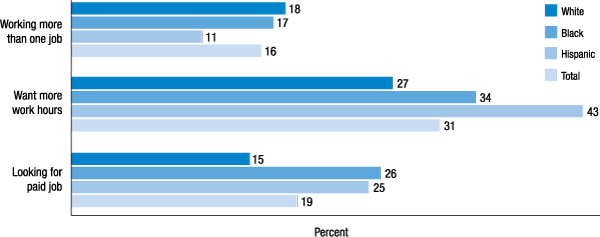
Note: Number of responses for "Working more than one job" and "Want more work hours" is 1,252 (have a paid job); for "Looking for paid job" is 2,097.
Black Respondents Have Lower Rates of Contingent Work
Because of an increase in the use of contingent workers over the past few decades, the availability of full-time, permanent jobs has decreased in the U.S. labor market. As a result, young workers are increasingly likely to face job and financial uncertainty.
In the Survey of Young Workers, an analysis of respondents with a paid job revealed that black respondents were more likely to have a full-time job (70 percent) than white (66 percent) or Hispanic (64 percent) respondents. Furthermore, after removing respondents who were attending school, black respondents were still more likely to be working full time (83 percent) than white (78 percent) or Hispanic (68 percent) respondents.
When given the choice, respondents in the Survey of Young Workers overwhelming preferred steady work (67 percent) to higher pay (30 percent). Interestingly, black respondents were slightly less partial to steady work (60 percent) than white (70 percent) and Hispanic (67 percent) respondents.
Black respondents were also slightly more likely to have a permanent job (72 percent) than white (71 percent) or Hispanic (71 percent) respondents. However, in this scenario, when students are removed from the analysis, black respondents have a much lower rate of permanent jobs (68 percent) than white (80 percent) and Hispanic (79 percent) respondents. This may indicate that black students are finding permanent jobs in connection with their school but struggling to find permanency when entering the labor market full time.
White Respondents Lead in the Perception of Upward Career Mobility
In the Survey of Young Workers, 25 percent of respondents with paid employment described their position as a "career" rather than a "job." White respondents were most likely to describe their job as a career (28 percent) compared with black (16 percent) and Hispanic (23 percent) respondents (figure 5). Based on these findings, it is not surprising that white respondents were more likely to be satisfied with their compensation, benefits, and work schedule than black and Hispanic respondents. As noted earlier, these results correlate to the respondents' level of education.
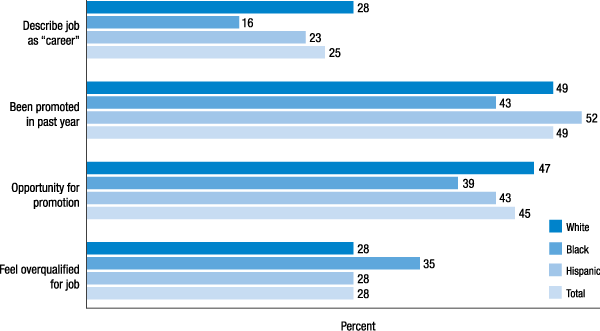
Black Respondents Lag in Financial Stability
On the same note, black respondents perceive fewer career opportunities than white or Hispanic respondents. Black respondents were least likely to have been promoted in the previous year (43 percent) and least likely to believe that they would receive a promotion at their job (39 percent) compared with white (49 percent and 47 percent, respectively) and Hispanic (52 percent and 43 percent, respectively) respondents. Furthermore, black respondents were more likely to report being overqualified for their job (35 percent) than white (28 percent) and Hispanic (28 percent) respondents. Correspondingly, black respondents were less likely to be satisfied with their compensation and benefits than the total sample.
In the Survey of Young Workers, black respondents (49 percent) were least likely to be able to cover their monthly living expenses when compared with white (68 percent) and Hispanic (61 percent) respondents (figure 6). Moreover, black respondents were least likely to be able to make ends meet if they were out of work for four weeks (21 percent) when compared with white (43 percent) and Hispanic (30 percent) respondents.
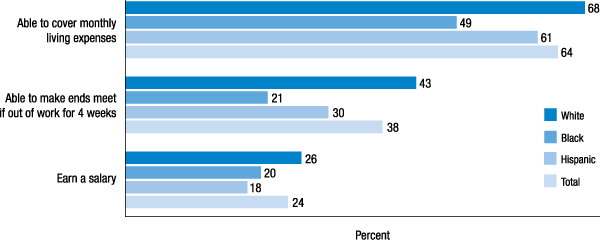
White Respondents Have Greater Access to Social Capital Networks
Research indicates that social capital and other intangible factors play a role in the uneven labor market outcomes between racial and ethnic groups. A study by the Urban Institute found that while it is unclear whether racially prejudiced employers, insufficient job networks, or limited work experience cause the labor market differences, it is clear that black youth (16- to 24-year-olds) are not obtaining full-time, steady work. Without an early foothold on the employment ladder, they do not move up the career ladders as fast as their white counterparts when they become young adults.9
In the Survey of Young Workers, white respondents were more likely to receive information about jobs and careers from their parents (43 percent) and friends (35 percent) than black (25 percent and 23 percent, respectively) and Hispanic (23 percent and 30 percent, respectively) respondents during their high school years (figure 7).

Job Outlook Is Consistent across Racial and Ethnic Groups
Despite the differences in education, job experience, and financials noted across racial and ethnic lines, young workers do not show a significant difference in their outlook about the future. Black (44 percent) and Hispanic (45 percent) respondents were as likely to be optimistic about their job future as white respondents (44 percent) (figure 8).
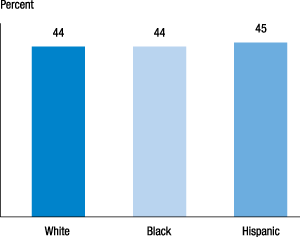
The Survey of Young Workers does not provide an explanation for the respondents' outlook not reflecting their reported experience across racial and ethnic lines. In general, young adults are more optimistic than older adults. It is likely that the optimism that is held by young adults in general plays a distinct role in these findings.
References
4. Pew Research Center (2014), Millennials in Adulthood: Detached from Institutions, Networked with Friends, Report (Washington: Pew Research Center), www.pewsocialtrends.org/2014/03/07/millennials-in-adulthood/ ![]() . Return to text
. Return to text
5. Andrew Sum, Ishwar Khatiwada, Mykhaylo Trubskyy, and Martha Ross with Walter McHugh and Sheila Palma (2014), The Plummeting Labor Market Fortunes of Teens and Young Adults (Washington: The Brookings Institution, March), www.brookings.edu/~/media/research/files/reports/2014/03/14%20youth%20workforce/youth_workforce_report_final.pdf ![]() . Return to text
. Return to text
6. Sum and others, The Plummeting Labor Market Fortunes of Teens and Young Adults. Return to text
7. Unemployment is defined as respondents who did not have a paid job and were seeking a paid job. Return to text
8. The labor force underutilization rate includes (1) those who do not have a job and are actively looking for one, (2) those who desire employment but are not actively looking, and (3) those who are working part-time but desire and are available for full-time work. Return to text
9. Margaret Simms and Marla McDaniel (2010), The Black-White Jobless Gap, Urban Institute brief (Washington: Urban Institute, September), www.urban.org/publications/901378.html ![]() . Return to text
. Return to text
